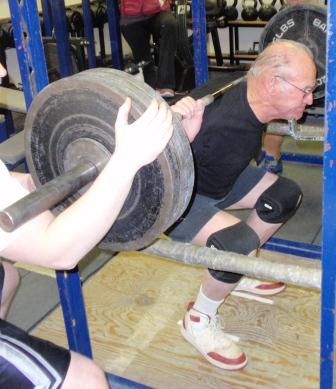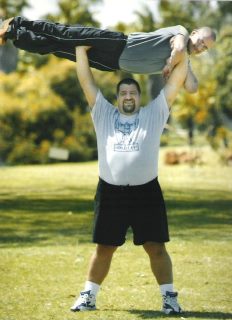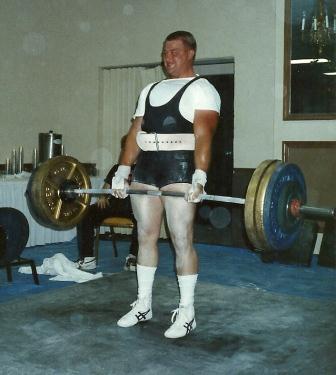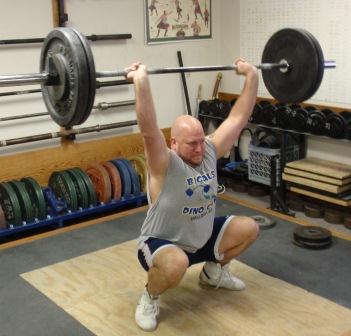Zercher Pull Throughs
by Al Myers
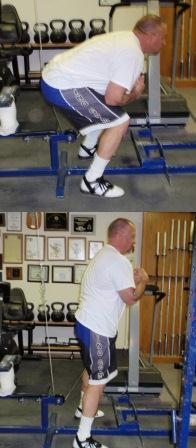
The top picture shows the bottom starting position of a Zercher Pull Through, while the bottom picture shows the finishing position.
I have written a blog before about how we “at the Dino Gym” do some light accessory movements after our hard Squat/Deadlift workout. In that story I covered one exercise that we really like – the Rounded Back Platform Deadlift. Look back in the blog archives to refresh your memory of that lift, as it is an excellent “finisher movement”. The purpose of these exercises is NOT TO BUILD STRENGTH (as hopefully your heavy training in the session up that point has already done that), but rather, to “wind down” a workout with an exercise that will increase the blood flow to the lower back and hips, and aid in the recovery process. I also like doing these movements as it is mentally refreshing as well. Up till this point the entire workout is about going ALL OUT, and then you get to “change gears” and do a movement that is not strength demanding to finish off the night, but instead stamina demanding. I’m not saying these movements are EASY though, sometimes they can leave you quite worn out. I’m not a big fan of high reps to build strength as I’ve never had success with getting stronger by training high reps. In my heavy stuff I never go over 5 reps, and most of the time it is 1-3 reps on lifts. But with these “finisher” movements I like to hit lots of reps – like up to 20 or so. I keep the rest short in between sets and do 3-5 sets total. It will leave you breathing hard as well! All the time you need to allot for a finisher movement is 15-20 minutes. Not a big commitment time wise – most guys spend more time than that packing their gym bag up after their workout.
Now onto the Zercher Pull Throughs. Pull Throughs are a popular exercise for lifters. The movement focuses on the lower back and hips. I have done them several different ways – with straps around the arms, ropes to the hands, etc. But the way I like them BEST is doing them Zercher style. I have not really read about anyone else doing them these way, but I’m sure others have done them this way as well. So I’m not presenting this movement as something original by me, but rather describe how I do this movement and why I like it. I perform this exercise using my lat pull. I have a low pulley that mounts below the seat that is used for the low lat seat. I attach a cable through this pulley to a short bar handle. The cable is the length that allows me to position with the bar handle in the crooks of my arms in a low stance (as demonstrated in the picture). I lean slightly forward and thrust upwards, extending the hips and straightening the legs. I lower slowly, and at all times keeping tension, and then do another rep. There is never a break in the action during these high rep sets. Use a weight that forces you to work hard but not cause a break down in proper form. Focus on maintaining proper breathing and just “feel the burn” in the hips and lower back as you add reps! It is a very simple movement.
Why do I like these Zercher Pull Throughs more than other types of Pull Throughs? Like I’ve said, I’ve tried all types and even have special straps made to do them other ways. I would like to say the reason is because I just love Zerchers so much as that is the reason, but in truth, it comes down to TWO REASONS that have nothing to do with loving the Zercher Lift. The number one reason is that these Zercher Pull Throughs takes all stress of the arms and shoulders. Other Pull Throughs require you to be holding a strap of some kind in front of you. This puts pressure on the arms and shoulders, and makes those muscles come into play enough that they become the limiting factor in the exercise, and not the hips and back as it should be. Reason number two is kinda personal, lets just say a strap being rubbed continuously between the legs can result in friction burns to any body part in the vicinity. That’s not a desirable thing in any type of exercise!
Rig up your lat pull machine to give this exercise a try. I assure you that you will be impressed!
